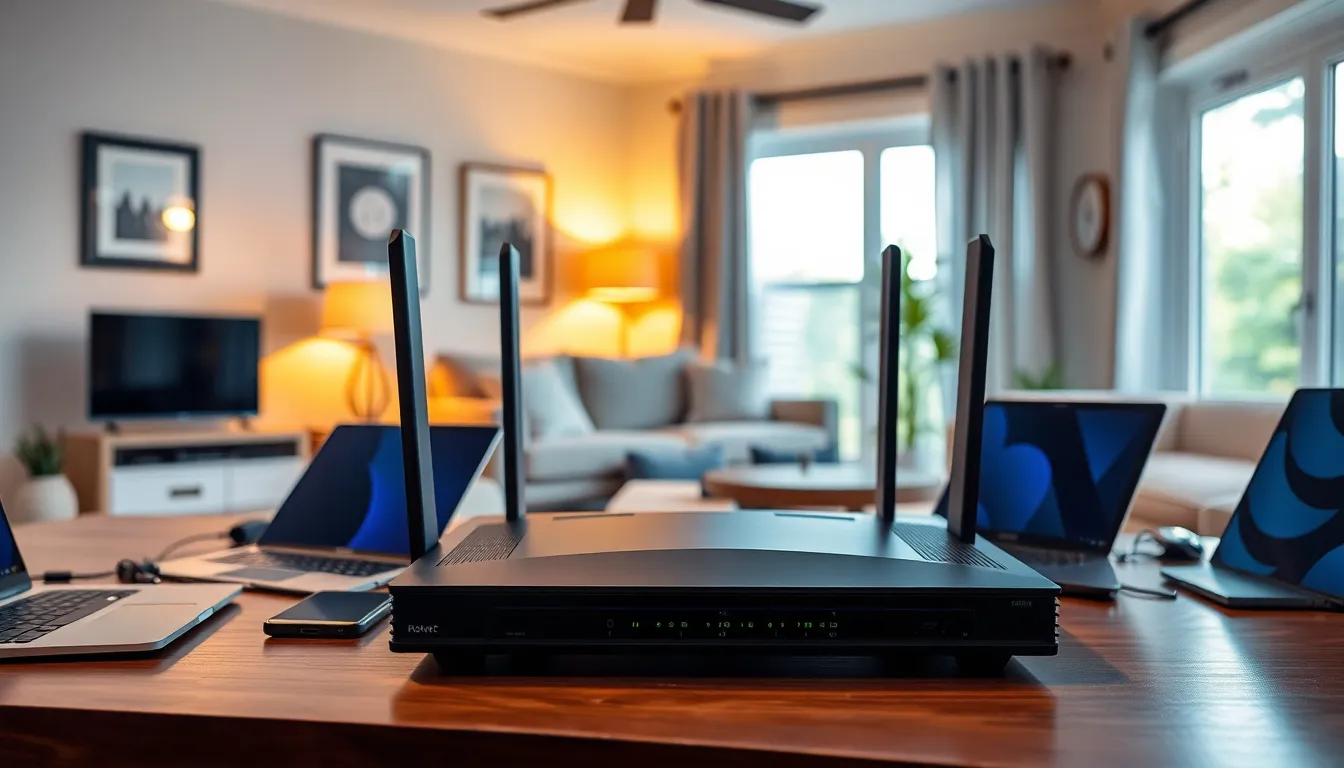In today’s digital age, a robust home network isn’t just a luxury; it’s a necessity. Imagine trying to stream your favorite show while your smart fridge is arguing with your thermostat over Wi-Fi bandwidth. Not exactly the serene home environment you envisioned, right? A well-structured home network can save you from tech chaos and keep your devices happily connected.
Table of Contents
ToggleUnderstanding Home Networks
Home networks serve as the backbone for connected devices. They enable communication between devices like smartphones, laptops, and smart home appliances, ensuring seamless connectivity across various applications.
What Is a Home Network?
A home network consists of interconnected devices that share resources and provide internet access. These devices can include computers, smartphones, tablets, printers, and smart appliances. Routers serve as the central hub, facilitating communication and internet access for all connected devices. In many cases, home networks can be wired, wireless, or a combination of both, adapting to different user needs and environments.
Importance of a Home Network
Establishing a robust home network significantly enhances the user experience for digital activities. Multiple devices often compete for bandwidth, leading to disruptions during streaming or online gaming. With a well-structured network, users enjoy consistent internet connectivity, minimizing interruptions. This reliability supports the growing number of smart devices that increasingly populate households. A strong network allows for efficient home automation, remote work capabilities, and uninterrupted communication among devices.
Setting Up Your Home Network

Setting up a home network requires careful planning and the right equipment. Following specific steps streamlines the process and ensures efficient functioning.
Choosing the Right Equipment
Selecting appropriate equipment forms the foundation of a home network. A high-quality router supports multiple devices and delivers stable internet connections. Many prefer dual-band routers, which operate on both 2.4 GHz and 5 GHz frequencies, reducing interference. Buying a router with advanced features, such as Quality of Service (QoS), prioritizes bandwidth for critical applications like streaming and gaming. Additionally, including a modem that is compatible with the chosen internet service significantly improves performance. Consider mesh Wi-Fi systems for larger homes, as they extend coverage effectively. Ensure the equipment meets current standards, such as Wi-Fi 6, to future-proof the network.
Step-by-Step Setup Process
Executing a systematic setup process ensures optimal network performance. First, connect the router to the modem using an Ethernet cable. Next, plug in the router and power it on before connecting to a computer or smartphone via Wi-Fi. Access the router’s configuration page through a web browser using its IP address. Set a unique network name and password to enhance security. Update the firmware to the latest version to benefit from essential security patches. Configure additional settings according to personal needs and device types. Once all devices are connected, test the network speeds and make adjustments as necessary. Regularly monitor network performance to address any issues proactively.
Configuring Your Home Network
Configuring a home network involves several crucial steps to ensure security and performance.
Securing Your Network
Securing a network protects personal data and devices. First, change the default username and password for your router to prevent unauthorized access. Next, enable WPA3 encryption, providing advanced security features. Consider creating a guest network for visitors, isolating their access from primary devices. Regularly updating firmware keeps vulnerabilities in check. Implementing a strong password for Wi-Fi minimizes the chances of unauthorized users connecting. Using a VPN can provide an additional layer of security for data transmission. Consistently monitoring connected devices helps identify any unauthorized access, maintaining overall network integrity.
Optimizing Network Performance
Optimizing network performance enhances the user experience. Begin by placing the router in a central location to maximize coverage. Minimizing obstructions, such as walls or furniture, near the router can significantly improve signal strength. Dual-band routers should be utilized; the 5GHz band supports faster speeds while the 2.4GHz band provides wider coverage. Limiting the number of connected devices during peak usage times can prevent congestion. Quality of Service (QoS) settings allow prioritization of bandwidth for activities like gaming or streaming. Regularly checking for network congestion by using performance monitoring tools ensures optimal functionality of connected devices.
Troubleshooting Common Issues
Home networks can encounter various problems. Identifying these issues promptly can save time and frustration.
Identifying Common Problems
Devices might experience slow internet speeds, often caused by excessive bandwidth usage. Connectivity drops frequently can indicate router or modem issues. Error messages during streaming suggest problems with device compatibility or network settings. Inconsistent wireless signals may arise from obstructions or distance from the router. Overloaded networks may stem from too many devices connected simultaneously. Understanding these common problems helps users address them efficiently.
Tips for Effective Troubleshooting
First, restart the router and modem to refresh the connection. Next, ensure that the firmware is up to date as updates often fix bugs. Checking device connections can reveal if any device is misconfigured. Prioritize bandwidth usage by limiting access for non-essential devices. Using network management tools can assist in monitoring performance. If issues persist, consider resetting the router to factory settings to resolve deeper configuration problems.
A well-structured home network is crucial for seamless connectivity in today’s digital landscape. By choosing the right equipment and following best practices for setup and security, users can create a robust network that supports their smart devices and enhances their online experiences.
Regular monitoring and troubleshooting can help maintain optimal performance, ensuring that streaming gaming and remote work remain uninterrupted. With the right approach, anyone can transform their home network into a reliable backbone for modern living.



